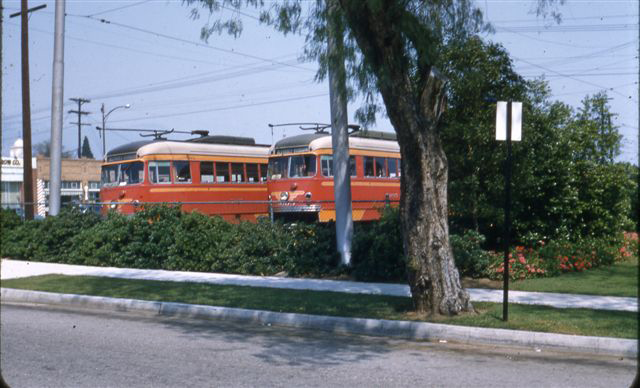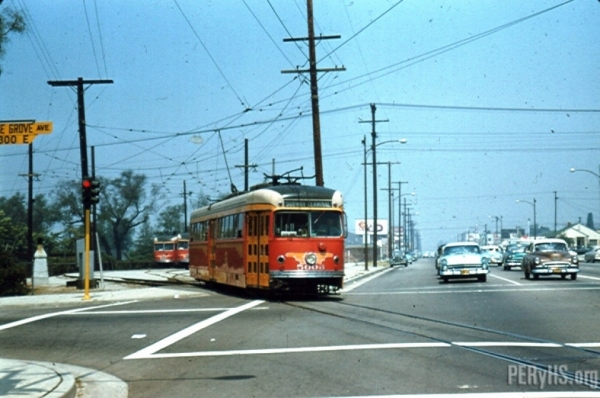Pacific Electric PCCs 5009 and 5017: Ready For The Final Curtain Call
By Ralph Cantos
This beautiful photo taken on the morning of June 18, 1955 shows Pacific Electric PCCs nos. 5009 and 5017 laying over at Burbank Yard. On a “normal” weekend, at least 8 to 10 PCCs would be stored at Burbank Yard waiting for the Monday morning rush hour on the very busy Glendale- Burbank Line.
BUT, that’s not going to happen on Monday morning, June 20th, 1955. The management of Metropolitan Coach Lines has pulled off the “unthinkable:” 48 new General Motors passenger buses will begin service on a longer, meandering route form Burbank to the congested streets of Downtown Los Angeles, replacing the the PCCs and Hollywood cars used on the line.
The PCCs had a seating capacity of 59 passengers, and the Hollywood cars 63 passengers each. In multiple-unit operation, the trains could move passengers by the hundreds in a single operational unit.
And yet, MCL management did not give a damn about providing fast, efficient service to several thousand commuters that used the line daily. MCL purchased the passenger operations of the PE for one reason, and ONE reason only… to rape the commuters of LA for the sake of financial profit.
In the case of the Burbank, MCL gave away key portions of right-of-way for the monumental sum of one dollar.
Later on this 18th day of June, 1955, the 5009, 5017, and the other PCCs stored at Burbank will make their final non-revenue run back to the Subway Terminal and a uncertain future. The Glendale-Burbank Line is in preparation for abandonment. MCL management used every underhanded tactic to “pull off the unthinkable” .. the destruction of a fast, modern rail service in favor of a slow, meandering bus line on congested city streets in the “name of progress.”
All the while city officials of LA, Burbank, and Glendale looked the other way … what a disgraceful, shameful bunch of bull!
Ralph Cantos Collection
ADDENDUM:
I am so happy that folks are still interested in the PE. The cars entered and left the yard at Orange Grove Ave after the yard was rebuilt in 1949. Before 1949, the cars BACKED into the yard from PALM Ave. one block to the north. After abandonment, I believe a car wash was built on the property and was there for severl years. Then that was torn down and a Burbank Police sub-station built there. I am not sure what is there today, but one thing for sure, the nice park next to the yard is gone, along with the beautiful PCCs.. Ralph




It is now part of a municipal parking lot for the Burbank Police & Fire Headquarters building. Just a bunch of concrete and asphalt surrounded by red cinder block walls.
Greg, thanks for the up-date. The PE spent a ton of their own money to rebuild that yard and double track Glenoaks Blvd…and for WHAT !! Six years of good service before Metro Coach destroyed the whole thing.
Wonderful shots! As to the underhanded tactics, I can only offer this; self-centeredness, self-absorbtion and greed, while tragic, are not illegal. Much good has been lost to these in service to these the years.
The PCCs had a brief epilogue in Buenos Aires as I have mentioned before. I am very grateful. Myself and thousands of other commuters had a chance to ride and enjoy these wonderful, quiet and luxurious cars. Unfortunately, they did not work out in BA suburban service. BTW: They were originally intended for urban BA service on the 22 line, which exists to this day (buses).
If I remember the story correctly MCL was part of a transportation conglomorate owned by GM, whose ultimate goal was one car/one passenger. You can see why any kind of a transport system that carried masses of people safely, quickly and cheaply would totally defeat that goal.
Anyway, that’s the conspiracy theory.
Metro Coach may have had some connection with GM, but the holding company that was closely allied with GM, Firestone, Standard Oil, et al. was National City Lines, which bought the LA Ry. Yellow Car system from the Huntington estate. According to a retired manager, the Huntington interests were divesting operating properties and concentrating on “gilt-edged securities”. As he succinctly put it, “If it eats or has to be painted, you don’t want your money in it.” A similar situation prevailed in the Bay Area, where the owners of the Key System were, according to some reports, glad to sell off the operation to NCL. The only part of PE that was dealt to NCL were the Pasadena local streetcar lines, some of which had been replaced with buses in the 1920s.
MCL management prefered GM buses as they were the best at the time. BUT, even the best GM bus was nothing more then a SLUG when compared to a PCC. Everyone in the transit industry knew that fact, but did not give a damn. The name of the game in the 1950’s was to “cut cost” , at ALL cost.!!
And we should remember that PE bought over 200 GM buses in 1950 to cover the lines abandoned in that period before selling out to MCL. I remember when they had PE 2700 parked in front of the Public Library in Monrovia back in 1951. There was a card table set up on the sidewalk with “pro-bus” leaflets on it and company reps to answer any questions. No, I did not collect any of the “propaganda” for my files.
I will not make excuses for the MCL or lATL management, but I will state the obvious regarding some economic and political considerations that favored substitution of buses over rail services. First, rather than MCL or LATL having to maintain the rail and electric plant, the taxpayer maintained the streets. Second, abandoning the rail/electric infrastructure meant eliminating assets subject to property taxes. Of course, eliminating rail service meant eliminating politician complaints advocating that their cities be rid of what the politicians considered antiquated transit vehicles and unsightly overhead and rails. Nobody considered the poor service to transit customers, air pollution, or resulting traffic congestion nor did the cities consider the lost property taxes. Then, as now, profit, rather than service ruled.
One of the Glendale city council members was so anxious to pave over the PE rails in Brand Blvd. The city ordered the paving company to start on the Monday after abandonment. The pavers not only covered the PE rails, they also paved over the man-hole covers. The city had to go back and dig up the new asphalt.
SyBB
I’ll toss in another economic point–when PE and LATL ran buses, they had to pay commercial vehicle license fees. Once quasi-governmental entities like LAMTA and SCRTD took over, the buses were issued “exempt” plates.
Back then the smart move on the part of the state would have been to buy out the PE and LARy to preserve all that infrastructure and rights of way for future use. All that could have been upgraded and modernize to provide a real public transit alternative to the automobile.